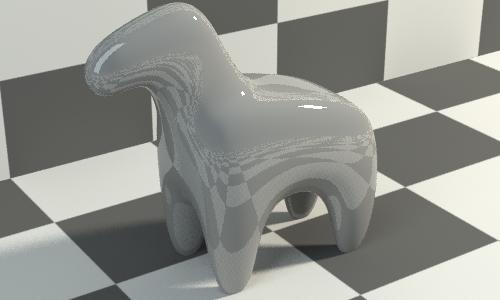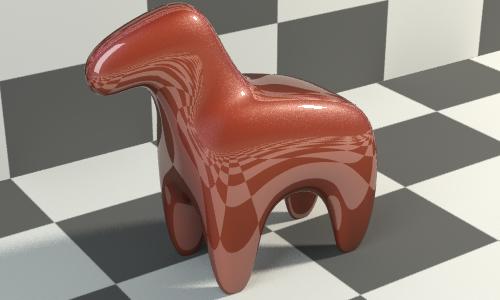

As we saw already in the previous page, mia_material reflection behavior can be emulated exactly. As a matter of fact, almost every aspect can be simulated, and a Phenomenon could be built to mimic the behavior of mia_material for most settings.
The trick is perhaps that mia_material has several switches that turn features on or off, and in general this may need to be simulated with different layering setups. For example, mia_material inherently behaves differently if "thin_walled" mode is on or off - for the layering shaders, the "thin_walled" option is on the mila_material. And the cutout feature is implemented as visibility, yet any given layer could have transperency as a component.
The following is a listing for a mia_material "behave-a-like" Phenomenon called mila_layer_mia_material.
This is just an example of something like an mia_material could be made. It is probably more optimal to use the layering shaders directly, but if one has a scene where one wants to mix existing mia_materials, this could help.
declare phenomenon
color "mila_layer_mia_material" (
scalar "diffuse_weight" default 1.0, #: min 0.0 max 1.0
color "diffuse" default 0.5 0.5 0.5,
scalar "diffuse_roughness" default 0.0, #: min 0.0 max 1.0
scalar "reflectivity" default 0.6, #: min 0.0 max 1.0
color "refl_color" default 1.0 1.0 1.0,
scalar "refl_gloss" default 1.0, #: min 0.0 max 1.0
scalar "refl_gloss_quality" default 1.0, #: min 0.0 softmax 4.0
scalar "transparency" default 0.0, #: min 0.0 max 1.0
color "refr_color" default 1.0 1.0 1.0,
scalar "refr_gloss" default 1.0, #: min 0.0 max 1.0
scalar "refr_ior" default 1.4, #: min 0.1 softmax 2.0
scalar "refr_gloss_quality" default 1.0, #: min 0.0 softmax 4.0
boolean "refr_translucency" default off,
color "refr_trans_color" default 0.7 0.6 0.5,
scalar "refr_trans_weight" default 0.5, #: min 0.0 max 1.0
scalar "anisotropy" default 1.0, #: min 0.1 softmax 10
scalar "anisotropy_rotation" default 0.0, #: softmin 0 softmax 1
integer "anisotropy_channel" default -1, #: min -1 softmax 64
integer "brdf_fresnel_mode" default 1, #Custom curve (aka manual), while 0 Fresnel uses refr_ior
scalar "brdf_0_degree_refl" default 0.2, #: min 0.0 max 1.0
scalar "brdf_90_degree_refl" default 1.0, #: min 0.0 max 1.0
scalar "brdf_curve" default 5.0, #: min 0.1 softmax 20
# Reflection/Refraction optimizations & falloffs
boolean "refl_falloff_on" default off,
scalar "refl_falloff_dist" default 0.0,
boolean "refl_falloff_color_on" default off,
color "refl_falloff_color" default 0 0 0,
boolean "refr_falloff_on" default off,
scalar "refr_falloff_dist" default 0.0,
boolean "refr_falloff_color_on" default off,
color "refr_falloff_color" default 0 0 0,
# Factors
scalar "indirect" default 1.0, #: min 0 softmax 1.0
# Built in AO
scalar "quality" default 1.0, #: min 0.0 softmax 2.0
# Only one bump input
vector "overall_bump"
)
shader "refl_roughness" "mila_get_roughness" ("glossiness" = interface "refl_gloss")
# Reflections
shader "reflection" "mila_glossy_reflection" (
"roughness" = "refl_roughness",
"quality" = interface "refl_gloss_quality",
"anisotropy" = interface "anisotropy",
"aniso_angle" = interface "anisotropy_rotation",
"aniso_channel" = interface "anisotropy_channel",
"use_max_dist" = interface "refl_falloff_on",
"max_dist" = interface "refl_falloff_dist",
"use_max_dist_color" = interface "refl_falloff_color_on",
"max_dist_color" = interface "refl_falloff_color",
)
shader "refr_roughness" "mila_get_roughness" ("glossiness" = interface "refr_gloss")
# Refractions
shader "refraction" "mila_glossy_transmission" (
"roughness" = "refr_roughness",
"quality" = interface "refr_gloss_quality",
"ior" = interface "refr_ior",
"anisotropy" = interface "anisotropy",
"aniso_angle" = interface "anisotropy_rotation",
"aniso_channel" = interface "anisotropy_channel",
"use_max_dist" = interface "refr_falloff_on",
"max_dist" = interface "refr_falloff_dist",
"use_max_dist_color" = interface "refr_falloff_color_on",
"max_dist_color" = interface "refr_falloff_color"
)
# Translucency
shader "translucency" "mila_diffuse_transmission" (
"tint" = interface "refr_trans_color",
"indirect" = interface "indirect_multiplier"
)
# Diffuse
shader "diffuse" "mila_diffuse_reflection" (
"roughness" = interface "diffuse_roughness",
"indirect" = interface "indirect_multiplier",
"quality" = interface "quality"
)
# Transparency and Translucency live in a
# separate "sub layers" because they steal
# energy from eachother
shader "transmission" "mila_layer" (
"layers" [
{
"shader" "translucency",
"weight_tint" 1 1 1,
"weight" = interface "refr_trans_weight",
"use_directional_weight" off,
"on" = interface "refr_translucency"
},
{
"shader" "refraction",
"weight_tint" 1 1 1,
"weight" 1,
"use_directional_weight" off,
"on" on
}
]
)
#
# The main layers, mimicking mia_materials
# energy conservation logic
#
shader "mia_layers" "mila_layer" (
"layers" [
{
"shader" "reflection", # Reflection layer
"weight_tint" = interface "refl_color",
"bump" = interface "overall_bump",
"weight" = interface "reflectivity",
"use_directional_weight" on,
"directional_weight_mode" = interface "brdf_fresnel_mode",
"normal_reflectivity" = interface "brdf_0_degree_refl",
"grazing_reflectivity" = interface "brdf_90_degree_refl",
"exponent" = interface "brdf_curve",
"ior" = interface "refr_ior",
"on" on
},
{
"shader" "transmission", # Transparency+Translucency
"bump" = interface "overall_bump",
"weight_tint" = interface "refr_color",
"weight" = interface "transparency",
"use_directional_weight" off,
"on" on
},
{
"shader" "diffuse", # Diffuse
"bump" = interface "overall_bump",
"weight_tint" = interface "diffuse",
"weight" = interface "diffuse_weight",
"use_directional_weight" off,
"on" on
}
]
)
root = "mia_layers"
apply material, texture, shadow, photon
version 1
end declare
mia_material_emulator has the same parameters as mia_material(_x) with the following exceptions. Some of these differences could be hidden in a user interface or with simple mapping-shaders
These parameters from mia_material are missing or different:


Emulating the Car Paint shaders is actually more difficult, but generally because the car paint shaders are older and much less physical. This emulation will not be visually exact - it will rather be more realistic looking and much more physically plausible. The old car paint Phenomenon has the following problems:
It makes more sense to try clone the more "sensible" parameters for the car paint and build a new more physically correct Phenomenon, which retains some of the features of the old shaders, but that is much more realistic. Here is one attempt at such a Phenomenon - other versions could exist:
declare phenomenon
color "mila_layer_car_paint"
(
color "base_color" default 0.8 0.1 0,
color "edge_color" default 0 0 0,
scalar "edge_color_bias" default 1.0,
color "lit_color" default 0.6 0 0.2,
scalar "diffuse_weight" default 1.0,
color "flake_color" default 1 1 1,
scalar "flake_weight" default 1.0,
scalar "flake_density" default 0.8,
scalar "flake_strength" default 0.8,
scalar "flake_scale" default 0.1,
integer "flake_type" default 0,
integer "flake_cell_style" default 0,
scalar "flake_cell_size" default 0.3,
# New - more physical - parameters
scalar "flake_roughness" default 0.4,
scalar "glossy_paint_weight" default 0.1,
scalar "glossy_paint_roughness" default 0.6,
color "clearcoat_1_color" default 1 1 1,
scalar "clearcoat_1_weight" default 1.0,
scalar "clearcoat_1_roughness" default 0.0,
color "clearcoat_2_color" default 1 1 1,
scalar "clearcoat_2_weight" default 0.0,
scalar "clearcoat_2_roughness" default 0.4,
scalar "clearcoat_ior" default 1.8,
scalar "quality" default 1.0,
scalar "max_distance" default 0.0,
# Dirt
color "dirt_color" default .3 .3 .3,
scalar "dirt_weight" default 0.0,
scalar "irradiance_weight" default 1.0,
)
shader "flakes" "mila_bump_flakes" (
"weight" = interface "flake_weight",
"scale" = interface "flake_scale",
"perturbation" = interface "flake_strength",
"density" = interface "flake_density",
"type" = interface "flake_type",
"circle_size" = interface "flake_cell_size",
"cell_style" = interface "flake_cell_style",
)
shader "dirt" "mila_diffuse_reflection" (
"tint" = interface "dirt_color",
"indirect" = interface "irradiance_weight"
)
shader "clearcoat_2" "mila_glossy_reflection" (
"roughness" = interface "clearcoat_2_roughness",
"quality" = interface "quality"
)
shader "clearcoat_1" "mila_glossy_reflection" (
"roughness" = interface "clearcoat_1_roughness",
"quality" = interface "quality"
)
shader "flakes_gloss" "mila_glossy_reflection" (
"tint" = interface "flake_color",
"roughness" = interface "flake_roughness",
"quality" = interface "quality"
)
shader "glossy_paint" "mila_glossy_reflection" (
"roughness" = interface "glossy_paint_roughness",
"quality" = interface "quality"
)
shader "edge_diffuse" "mila_diffuse_reflection" (
"tint" = interface "edge_color",
"indirect" = interface "irradiance_weight"
)
shader "main_diffuse" "mila_diffuse_reflection" (
"tint" = interface "base_color",
"indirect" = interface "irradiance_weight"
)
shader "mia_layers" "mila_layer" (
"layers" [
{
"shader" "dirt",
"weight" = interface "dirt_weight",
"weight_tint" 1 1 1,
"on" on
},
{
"shader" "clearcoat_1",
"weight" = interface "clearcoat_1_weight",
"weight_tint" = interface "clearcoat_1_color",
"use_directional_weight" on,
"directional_weight_mode" 0,
"ior" = interface "clearcoat_ior",
"on" on
},
{
"shader" "clearcoat_2",
"weight" = interface "clearcoat_2_weight",
"weight_tint" = interface "clearcoat_2_color",
"use_directional_weight" on,
"directional_weight_mode" 0,
"ior" = interface "clearcoat_ior",
"on" on
},
{
"shader" "flakes_gloss",
"weight" = "flakes.visibility",
"weight_tint" 1 1 1,
"bump" = "flakes.normal",
"on" on
},
{
"shader" "glossy_paint",
"weight" = interface "glossy_paint_weight",
"weight_tint" = interface "lit_color",
"on" on
},
{
"shader" "edge_diffuse",
"weight" = interface "diffuse_weight",
"weight_tint" 1 1 1,
"use_directional_weight" on,
"directional_weight_mode" 1,
"normal_reflectivity" 0.0,
"grazing_reflectivity" 1.0,
"exponent" = interface "edge_color_bias",
"on" on
},
{
"shader" "main_diffuse",
"weight_tint" 1 1 1,
"weight" = interface "diffuse_weight",
"on" on
}
]
)
root = "mia_layers"
apply material, texture, shadow, photon
version 2
end declare
This Phenomenon is built from these 7 layers (top to bottom):

